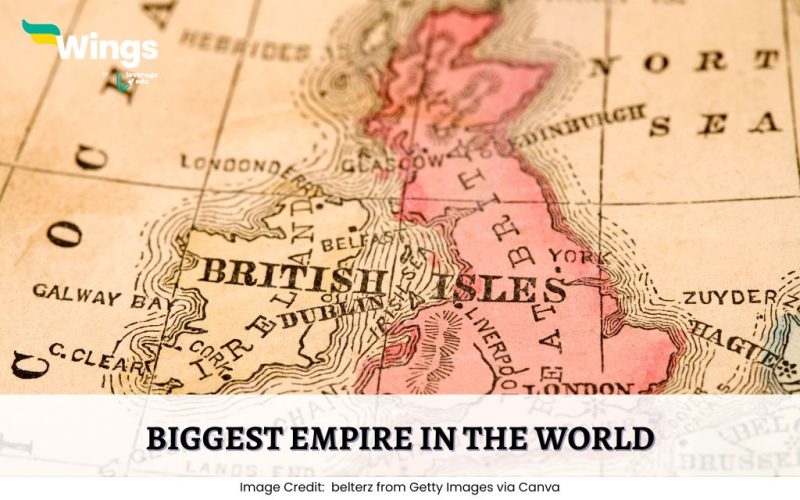The biggest empires in the world have shaped human history. Their impact is so strong that you cannot understand history without learning about these empires. Popular empires like the Mongol Empire, which created the largest contiguous land, and the British Empire shaped international politics and trade, have left their mark on the world. They have successfully refined borders, cultures, and economies. The biggest empires were built due to military conquests and even exploration, like the case of the Portuguese. Each empire did something that changed the world. So why not study them? This blog covers facts about the largest empire in history.
Table of Contents [show]
Which is the Largest Empire in History?
Did you the largest empire in history was the British Empire? The British Empire at its peak (1919) was spread across 35.5 million square kilometers. This was around one-tenth of the Earth’s land area! The British Empire held its territories in Africa, Asia, the Americas, and Oceania. It was so huge that the phrase ‘the empire on which the sun never sets’ became common.

How Many Countries were Under British Rule?
What makes the British Empire the biggest empire in the world is its history is the number of countries it held. The countries which were held by the British Empire as follows-
| Region | Major Countries Colonised by Britain |
| Asia | India, Pakistan, Bangladesh, Malaysia, Myanmar, Sri Lanka |
| Africa | South Africa, Nigeria, Kenya, Egypt, Sudan, Zimbabwe |
| Americas | Canada, United States (before independence), Jamaica, Guyana |
| Oceania | Australia, New Zealand, Fiji |
| Middle East | Iraq, Palestine, Jordan, Yemen |
Top 10 Biggest Empires in the World
The following are the largest empires in history that you must know about. Learn about these empires and tell us which fact shocked you the most.
1. British Empire
Britain had the biggest empire in the world. The empire was spread across 35.5 million square kilometers during its peak period. The British were able to successfully set up their colonies in Asia, Africa, and the Americas. They shaped global governance and language. Moreover, they played an important role in industrialization and politics after the Second World War. The British Empire was the first to adopt standardized time zones (GMT) in 1884. The empire’s largest export was opium.
2. Mongol Empire
The Mongol Empire was the second biggest empire in the world. This empire was set up by Genghis Khan. Genghis Khan’s empire spanned across 24 million square kilometers! He is known for his military conquests, particularly connecting Asia and Europe through the Silk Road. Genghis Khan is the person who abolished torture. Moreover, he granted religious freedom to people in his empire. The Mongol Empire used to use “arrow riders,” a postal system that had stations every 40 km to send messages.
3. Russian Empire
The third biggest empire in the world was the Russian Empire. This empire was spread across 22.8 million square kilometers. It covered areas like Siberia, Europe, and Central Asia. The empire played a significant role in international politics. However, it declined after the Russian Revolution of 1917. Russia had once sold Alaska to the U.S. for $7.2 million in 1867. The reason? They thought it was a frozen wasteland!
4. Spanish Empire
The fourth biggest empire in the world was the Spanish Empire. The empire spanned across 13.7 million square kilometers. This means much of Central and South America, and even parts of North America, were under its control. During the age of exploration, Spain was a major power. Moreover, the Spanish culture, religion and language were popular.
Did you know?
The Spanish dollar (real de a ocho) was the first global currency in the world? It even inspired the introduction of the US dollar. Spain was also the country that introduced tomatoes, potatoes and chocolates to Europe.
5. Qing Dynasty of China
The Qing Dynasty controlled around 14.7 million square kilometers. This enabled China to be influential in trade and commerce. However, internal struggles of the empire led to its downfall in 1912. The Qing emperor Kangxi was able to rule the Dynasty for 61 years (1661–1722), and became the longest-reigning emperor in the history of China. The Qing banned foot-binding multiple times. However, it continued till the end of the 20th century.
6. Umayyad Caliphate
The Umayyad Caliphate is another one of the biggest empires in the world. This empire was spread across North Africa, Spain, the Middle East, and Persia. This empire was significant because it played a crucial role in the advancement of art, science and trade. They were the ones who built one of the oldest monuments of Islam, the Dome of the Rock in Jerusalem. Moreover, they made Arabic the official language of the empire.
7. French Colonial Empire
The French Empire controlled 11.5 million square kilometers. This means African territories, and Southeast Asia, and the Caribbean territories were under them. France was able to influence the global culture, governance and language. However, they lost several territories after the 2nd World War. Did you know France used to own Louisiana, and sold it to the US in 1803? Another interesting fact is that the French exported the guillotine to their colonies, calling it a humane way of execution!
8. Ottoman Empire
The Ottoman Empire was another one of the biggest empires in the world. This empire was able to control around 5.2 million square kilometers. This means the Middle East, Southeast Europe, and much of North Africa was under its control. Although they were a dominant force in trade and politics, the empire declined after the 1st World War.
The Ottomans were successful in inventing the 1st military marching band. This inspired European military music! On the negative side, they followed a “silent” harem hierarchy. This means the concubines could become the mothers of Sultans. For example, Roxelana.
9. Portuguese Empire
The Portuguese empire spanned across 10,4 million square kilometres. This was one of the biggest empires of the world. They pioneered sea exploration. Moreover, they set up colonies in Africa, Brazil, and Asia. The Portuguese were able to monopolise the spice trade. They were the ones who discovered the sea route to India. To be precise, Vasco da Gama. The Portuguese were also of the first to establish the global slave trade. They transported Africans to Brazil before any European power did!
10. The Ming Dynasty of China
The Ming Dynasty of China was another one of the biggest empires in the world. It spanned across 6.5 million square kilometers. Therefore, the military and economy of China gained strength. The Ming Dynasty is credited with building the Great Wall of China. Moreover, they traded with Europe. They even built the Forbidden City with the help of 1 million laborers and 200,000 artisans. Moreover, they launched Zheng He’s treasure fleets. These ships were 5 times larger than Columbus’s ship, and reached Africa!
FAQs – Biggest Empire in the World
There are no historical records to support the claim that Vikramaditya was the world’s largest empire. It is just a legend and belief in India. There is no ruler in India named Vikramaditya who was able to control the Indian empire.
The top 5 biggest empires of the world are the British Empire (13.71 million mi2), the Mongol Empire (9.27 million mi2), the Qing Dynasty (5.68 million mi2), and the Spanish Empire (5.29 million). The Russian Empire (8.8 million mi2) was also one of the biggest empires.
The biggest empire in India was the Mauryan Empire. This empire lasted from 322-185 BC. It was able to unify most of the Indian subcontinent.
Related Reads
These were the facts about the biggest empire in the world. If you find it fascinating and wish to read more such interesting facts, then stay tuned to the General Knowledge page of Leverage Edu.
 One app for all your study abroad needs
One app for all your study abroad needs















 45,000+ students trusted us with their dreams. Take the first step today!
45,000+ students trusted us with their dreams. Take the first step today!
